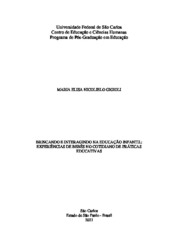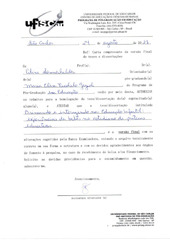| dc.contributor.author | Gigioli, Maria Elisa Nicolielo | |
| dc.date.accessioned | 2021-08-25T11:06:51Z | |
| dc.date.available | 2021-08-25T11:06:51Z | |
| dc.date.issued | 2021-06-30 | |
| dc.identifier.citation | GIGIOLI, Maria Elisa Nicolielo. Brincando e interagindo na educação infantil: experiências de bebês no cotidiano de práticas educativas. 2021. Tese (Doutorado em Educação) – Universidade Federal de São Carlos, São Carlos, 2021. Disponível em: https://repositorio.ufscar.br/handle/ufscar/14805. | * |
| dc.identifier.uri | https://repositorio.ufscar.br/handle/ufscar/14805 | |
| dc.description.abstract | The research is based on the understanding that babies are capable of learning and that they are powerful from birth, thus, it investigates their interactions in the context of daycare based on the following questions: How do babies interact with their peers and adults when expressing themselves playing in the daycare context? How do babies interact with toys, objects, and space while playing? As a result of these questions, the research aims to identify, describe and analyze, through playing, the interactions of babies with their peers, adults, toys, objects, and space during playtime in the Nursery. We understand that children have numerous languages such as babbling, facial and body expressions, but the focus of this investigation is the language of play. Initially, a bibliographic survey was carried out to substantiate the social and scientific relevance of the research, followed by theoretical framework research whose main themes were: Emmi Pikler's approach, understanding about babies, early childhood education in Ministry documents of Education, educating, caring and playing as a function of Early Childhood Education. With a qualitative approach, the investigation was carried out in a municipal daycare center in a city in the countryside of São Paulo, with 13 babies from the Nursery I class and four educators responsible for the class. The investigation was restricted to looking at the moments of playing that occur from the availability of toys and objects to babies, by the educators. The instrument used to collect the data was the interactive observation and it was registered through video, followed by the full written transcript, with 24 transcripts referring to the 24 data collection sessions that lasted approximately 30 minutes each. The organization of the collected data was made based on content analysis. As the last stage of this analysis, the results were analyzed in the light of the theoretical framework, having as primary authors: Falk, Tardos, Tardos and Szanto-Feder, Soares, Kálló and Balog, Gonzalez-Mena and Eyer, Barbosa, Rinaldi. The results revealed that the interactions and games experienced by the babies took place in a context with no offer of qualified experiences and situations. An example of this was the organization of the space to play, which remained in the same way, with the same toys and objects, without careful observation, planning, or educational intention on the part of the educators so the babies were encouraged in their actions. Therefore, we discussed some aspects that contribute to spontaneity practices that are present in early childhood education, such as in the context of teacher education in Brazil, indicating the necessity of studies that contribute to the implementation of qualified practices in daycare centers. The research revealed the importance of providing babies with the true experience which gives opportunities for interactions and games in a challenging environment and that encourages them in their discoveries. Therefore, it is considered necessary to change educational practices with babies from 0 to 3 years to educate and transform them. | eng |
| dc.description.sponsorship | Não recebi financiamento | por |
| dc.language.iso | por | por |
| dc.publisher | Universidade Federal de São Carlos | por |
| dc.rights | Attribution-NonCommercial-NoDerivs 3.0 Brazil | * |
| dc.rights.uri | http://creativecommons.org/licenses/by-nc-nd/3.0/br/ | * |
| dc.subject | Bebês | por |
| dc.subject | Interação | por |
| dc.subject | Linguagem do brincar | por |
| dc.subject | Educação infantil | por |
| dc.subject | Abordagem de Emmi Pikler | por |
| dc.subject | Babies | eng |
| dc.subject | Interaction | eng |
| dc.subject | Language of Play | eng |
| dc.subject | Early Childhood Education | eng |
| dc.subject | Emmi Pikler Approach | eng |
| dc.title | Brincando e interagindo na educação infantil: experiências de bebês no cotidiano de práticas educativas | por |
| dc.title.alternative | Playing and interacting in early childhood education: experiences of babies in everyday educational practices | eng |
| dc.type | Tese | por |
| dc.contributor.advisor1 | Sommerhalder, Aline | |
| dc.contributor.advisor1Lattes | http://lattes.cnpq.br/4775432120371947 | por |
| dc.description.resumo | A pesquisa parte da compreensão de que os bebês são seres capazes de aprender, são potentes, desde o nascimento e assim, investiga suas interações no contexto da creche a partir dos seguintes questionamentos: De que maneira bebês interagem com seus pares e adultos ao se expressarem no brincar no contexto da creche? Como bebês, brincando, interagem com brinquedos, objetos e espaço? Decorrido destas questões a pesquisa objetiva identificar, descrever e analisar as interações de bebês com seus pares, adultos, brinquedos, objetos e espaço nos momentos de brincadeira no Berçário. Compreendemos que as crianças possuem inúmeras linguagens como balbucios, expressões faciais, corporais, mas o foco dessa investigação é a linguagem do brincar. Inicialmente realizou-se um levantamento bibliográfico para fundamentar a relevância social e científica da pesquisa, seguida de uma pesquisa de referencial teórico cujos principais temas abordados foram: a abordagem de Emmi Pikler, compreensão acerca dos bebês, a educação da primeiríssima infância nos documentos do Ministério da Educação, educar, cuidar e brincar como função da Educação Infantil. De abordagem qualitativa, a investigação foi realizada em uma creche municipal de uma cidade do interior de São Paulo, com 13 bebês da turma do Berçário I e 4 educadoras responsáveis pela turma. A investigação delimitou-se a olhar para os momentos do brincar que ocorrem a partir da disponibilização de brinquedos e objetos aos bebês, pelas educadoras. O instrumento para coletar os dados foi a observação participante e para registrá-los utilizou-se o recurso da vídeogravação, seguido da transcrição escrita na íntegra que totalizou 24 transcrições referentes às 24 sessões de coleta de dados que teve duração aproximada de 30 minutos cada. A organização dos dados coletados foi realizada a partir da análise de conteúdo. Como última etapa dessa análise, os resultados foram analisados à luz do referencial teórico, tendo como principais autores: Falk, Tardos, Tardos e Szanto-Feder, Soares, Kálló e Balog, Gonzalez-Mena e Eyer, Barbosa, Rinaldi. Os resultados revelaram que as interações e brincadeiras vivenciadas pelos bebês ocorreram em um contexto de inexistência da oferta de experiências e situações qualificadas. Exemplo disso foi a falta de organização do espaço para brincar, que se manteve do mesmo modo, com a disponibilização dos mesmos brinquedos e objetos, sem observação atenta, planejamento ou intencionalidade educativa por parte das educadoras para que os bebês fossem incentivados em suas ações. Diante disso, problematizou-se alguns aspectos que concorrem para que práticas espontaneistas estejam presentes na educação da primeiríssima infância, como o contexto da formação de professores no Brasil, indicando a necessidade de estudos que contribuam com a efetivação de práticas qualificadas nas creches. A pesquisa apontou a importância de proporcionar aos bebês a verdadeira experiência, a que oportuniza interações e brincadeiras em um ambiente desafiador, que incentive os bebês em suas descobertas. Para tanto, considera-se necessário uma mudança das práticas educativas na educação de 0 a 3 anos a fim de termos uma educação para os bebês que os forma e transforma. | por |
| dc.publisher.initials | UFSCar | por |
| dc.publisher.program | Programa de Pós-Graduação em Educação - PPGE | por |
| dc.subject.cnpq | CIENCIAS HUMANAS::EDUCACAO | por |
| dc.publisher.address | Câmpus São Carlos | por |
| dc.contributor.authorlattes | http://lattes.cnpq.br/4258533015353852 | por |


